Working with files
Malcat is first and foremost a file analysis tool. It can Open a local file, Compare two files and supports multiple files open in parallel. It can also Open sub-files and objects, thanks to its numerous archive formats parsers and the use of a fast File carving. This chapter will guide you through most of these features.
Open a local file
Malcat can open local files using different methods that are listed below. Note that by default, new files that you open are loaded inside a new tab/project (it’s not exactly a tab since a drop-down list is used, but it’s the same idea). Focus will be given to the new project, but the old one can still be accessed anytime (cf. Switch between files).
From the command line
To open a file from the command line, just pass it as argument: malcat /path/to/file/name. It works under both Windows and Linux. It you want to Compare two files, you can pass both file paths as arguments, it will work too.
Recent files
When run without any argument, Malcat display by default a welcome screen displaying the 10 last opened files. Double-clicking any of these files will re-open them into Malcat.

The recent files list
Drag and drop
Almost all of Malcat’s user interface surface supports drag and drop, with the exception a few controls (mostly the script editor window and the Yara editor window). Drag and dropping a file in Malcat will open it as if you used the menu. This works on Windows and Linux.
Big file mode
Malcat will automatically display a Big File Mode dialog when you open very large local files (threshold can be configured in , defaults to 256 Mb).
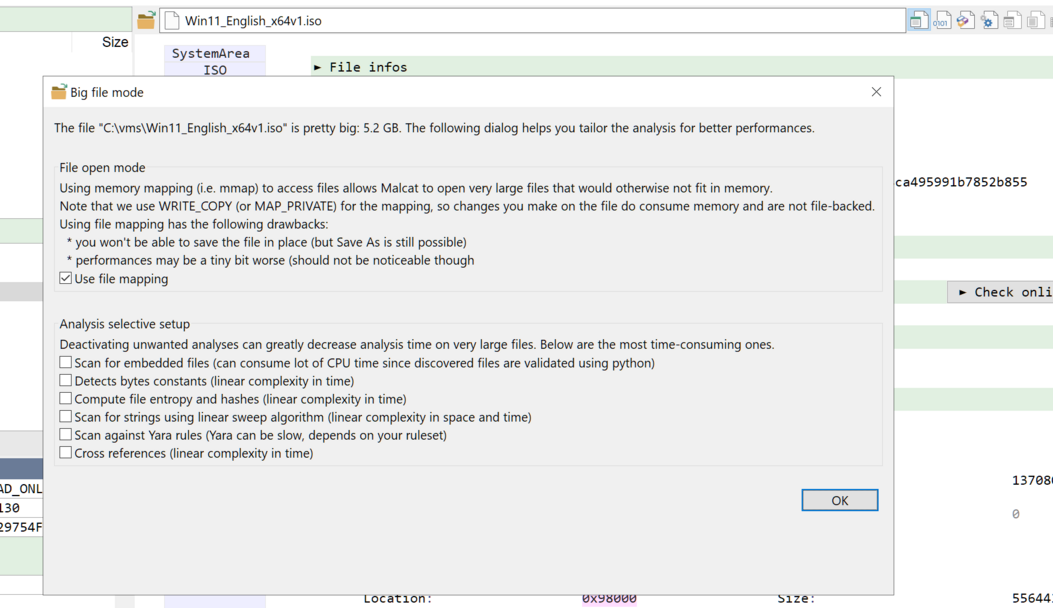
Big file mode dialog
In Big File Mode, arbitrarily large files can be open using memory-mapping. The trick is that file is open in read-only mode and we use a MAP_PRIVATE or WRITE_COPY memory-mapping. It means that modifications to the file are not file-backed but written in newly allocated memory. The software is in control of saving modified bytes. But since we opened the file in read-only mode, modifications have to be saved to another file. That’s a small price to pay (one does not modify 1Gb+ files every day) to support arbitrarily large files.
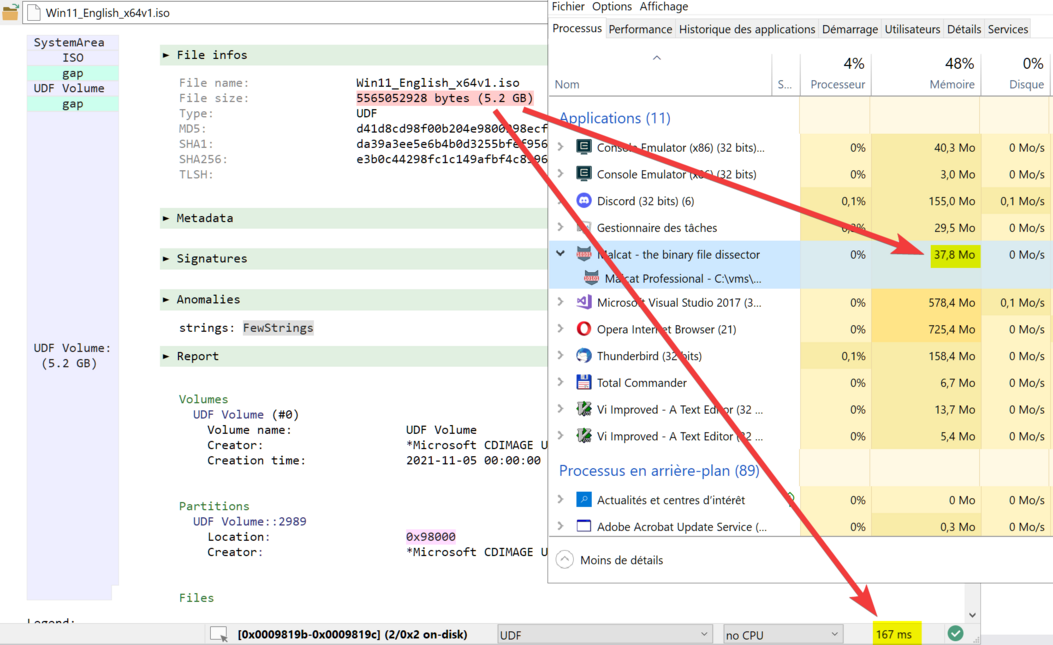
CPU and memory consumption on big files
The dialog additionally invites you to deactivate the most time-consuming analyses in order to speed-up the user experience. Doing file carving or scanning for cross-references on a 5Gb+ file is going to be somewhat slow no matter what. If you deactivate everything, Malcat will change to a somewhat basic hexadecimal editor, but opening the file will be instant.
Download a file by hash / from a url
Malcat is not only able to open local files, but it can also open remote files either from an http/https/ftp url or by simply giving the md5/sha1 or sha256 (preferred) hash of the sample you are looking for. The later mode will leverage Malcat’s numerous Threat intelligence providers providers to find a potential download source for the file that you are looking for. It is a pretty convenient method to get your hands on a sample that you have seen in a report when you don’t know where it has been uploaded to!
Note
In order to download samples by hash, you will first need to Configure the threat intelligence services and fill in your API keys. By chance, all these services offer at least some form of free account!
To download a remote file, you can either click on the Download ... button found in the Recent files screen or via the menu: . The dialog below will then appear in front of you. By clicking on Download, Malcat will try to find/download the file. In case of success, the Open file button will be enabled: clicking on it will open the file in Malcat!

Download a file by hash using threat intelligence providers
Opening files this way offers several advantages:
Files are not saved to disk until you pres Ctrl+S), meaning no annoying antivirus alert and no tedious file management
In case of download-by-hash, the file is automatically unpacked if found inside a password-protected file and its hash gets verified!
If you download a file by url, malcat will try to download the file using different user agents in order to bypass the most basic browser-fencing methods
Compare two files
Diff algorithms
Malcat can be pretty useful when it comes to comparing binary files. You can compare two files by:
Drag and dropping them anywhere on Malcat’s window
Passing two paths on the command line
Using the menu when a file is already open in Malcat
You will be greeted by a dialog where you can set some diffing options. The most important one is which diff algorithm to use. Malcat implements two of them:
A naive but very fast byte-by-byte comparison
Myers’s algorithm, an algorithm used in bioinformatics to compare DNA
While the naive algorithm may have it uses from time to time, it is basically worthless if you are facing data inserts and/or data deletion, since the two data flows won’t be aligned anymore and comparison will make little sense. That’s when Myers algorithm comes in play. This algorithm tries to align the files on the biggest common sequences and computes the data insertions/deletions/modifications accordingly.
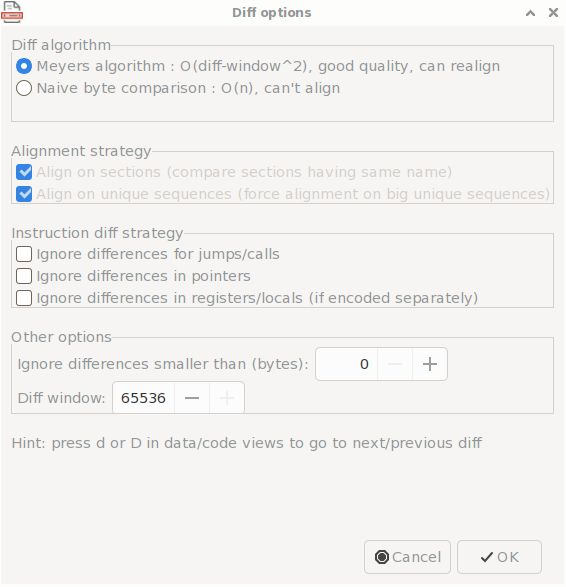
Diff options
The only drawback of Myers algorithm is its complexity: O(n2), which makes it useless on non-trivial binary files. To offset this issue, Malcat implements a diff window: only this amount of data (by default 64K) will be compared at a time. What it means is that if two similar blocks are separated by more than 64K bytes (after realignments), Malcat’s diff won’t notice their similarity.
Note
Malcat makes some cheap optimisations during diffing, like common prefix and common suffix search, so for this worst case scenario to happen, the two similar blocks need to be separated by 64k+ bytes and some other differences.
In practice, this worst case scenario is very rare when diffing programs, and mainly happens for files which are very much different.
Additional options
Additional options are offered to you when diffing files. Beside the diff window length option which has a direct impact on the accuracy of Myers algorithm, the other options are post-filtering options: they are used to remove or hide differences from the final result:
Ignore differences for jumps/calls: small diffs which are inside the encoding of a jump or call instructions are ignored (helps with code relocation)
Ignore differences in pointers: small diffs which are inside any instruction and which are valid virtual addresses are ignored (helps with code relocation)
Ignore differences in registers/locals: if a register or a local is encoded in a byte different than an instruction opcode, differences on this single byte will be ignored (helps against obfuscation)
Ignore differences smaller than: Ignore small differences, improves readability of the overall diff result.
Note that these options can’t be changed afterwards, you would have to re-diff the files to change them.
Open sub-files and objects
While Malcat can open multiple local files in parallel (cf. Open a local file), it can also open part of the current file, or an object, or a resource from within the current analyzed file into a new file. We will describe below what can be open and how.
Virtual files
We call virtual files all sub-files found by Malcat’s File parsers during parsing of the main file. They differ from carved files in that they are explicitly referenced by one of the file format structures as a sub-file or resource. They can be stored compressed (a ZIP archive member for instance), encrypted (e.g. an AutoIT script) or in plain text (e.g. a PE resource).
Malcat will list all virtual files under the Virtual File System tab, located on the top-left corner of the User interface. If a proper unpacking / decryption method is supported by Malcat, the virtual file may also be opened inside Malcat by double-clicking it.

You can choose to open sub-files into the same project, or into a new project
By default, a virtual file will be opened in the current tab / project window, as if you opened a link in a browser. Closing the virtual file (Ctrl+W) will then bring you back to the root file (think of a browser back button). If you want to have both the root file and the sub-file visible at the same time, this may be an unwanted behavior. You can instead force the virtual file to open as a new tab / project by choosing from the virtual file’s context menu. The file will be opened as a new project and you will be able to Switch between files using the project switcher (cf. User interface).
Carved files
We call carved files all sub-files identified by Malcat’s File carving. These are files of known type (i.e recognized by one of the many File parsers) that were found via a simple linear scan (ala Binwalk). These files could be stored anywhere within the file, even if not referenced by a structure. They are always stored in plain text (otherwise we would not be able to detect them).
Malcat will list all carved files under the Carved Files tab, located on the top-left corner of the User interface. Clicking on a carved files brings you to the file’s location in either the Hexadecimal view or the Structure/text view.
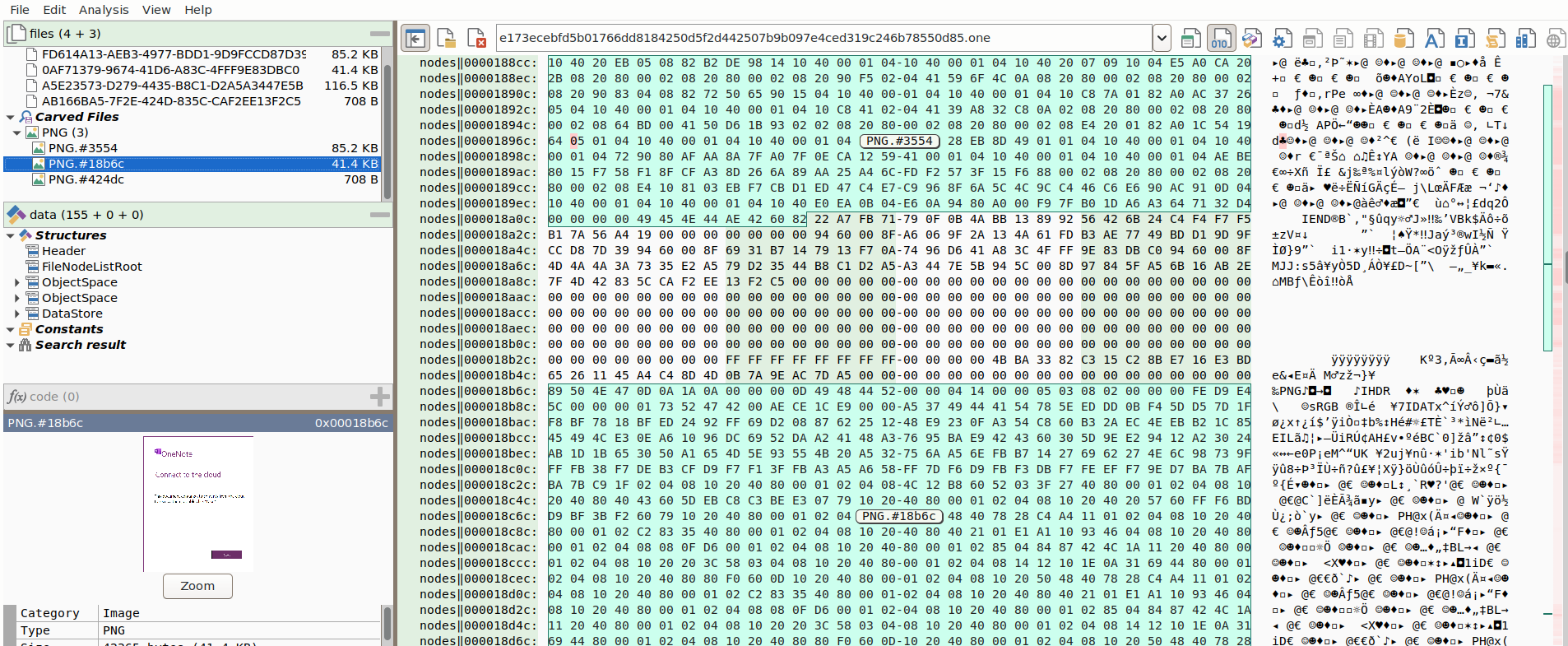
Two PNG files found inside a .ONE document
Double-clicking on a carved file opens it in the current tab / project window, as if you opened a link in a browser. Closing the carved file (Ctrl+W) will then bring you back to the root file (think of a browser back button). If you want to have both the root file and the sub-file visible at the same time, this may be an unwanted behavior.

Opening sub files within the current project / tab
You can instead force the carved file to open as a new tab / project by choosing from the carved file’s context menu. The file will be opened as a new project and you will be able to Switch between files using the project switcher (cf. User interface).
Selection
Every byte range that you select in Malcat can be opened as a new file, either inside the current project via or into a new tab / project.
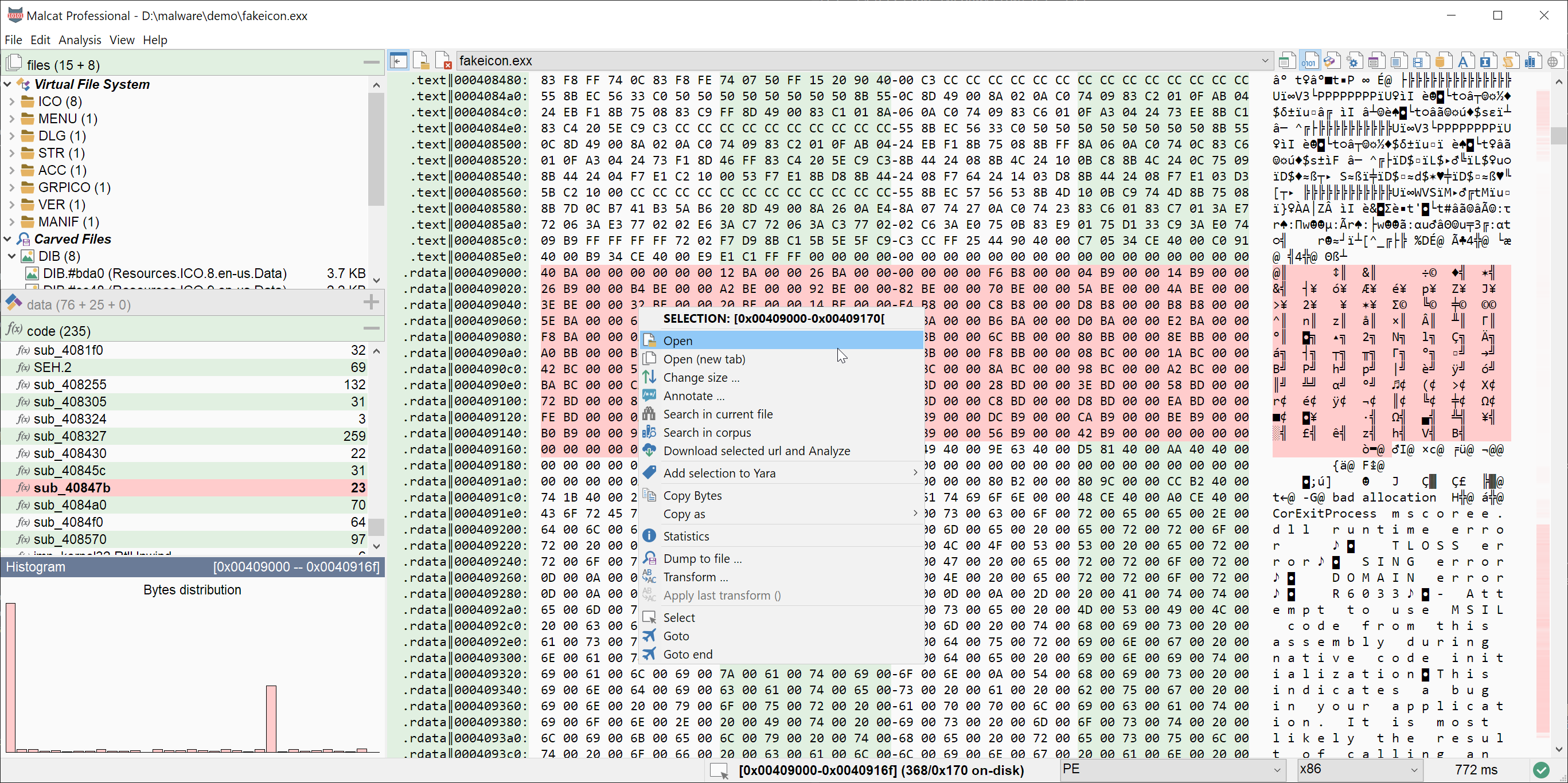
You can open any selected range as new file in Malcat
If you open the selection inside the current tab / project window, it would be as if you opened a link in a browser. Closing the selection (Ctrl+W) will then bring you back to the root file (think of a browser back button). If you want to have both the root file and the selection visible at the same time, this may be an unwanted behavior. You can instead force the selection to open as a new tab / project by choosing from the selection context menu. The file will be opened as a new project and you will be able to Switch between files using the project switcher (cf. User interface).
Files generated from scripts
Scripting in Malcat is pretty powerful and you can do many things using Malcat’s bindings. The user interface of Malcat also has a few bindings. By using the gui.open_after(data:bytes, name:str) method, scripts can open any arbitrary bytes buffer as a new file in the interface.
Note that the new file will be opened after the script has finished, hence the name, and only one file can be opened this way.
Switch between files
Malcat can keep multiple files open at the same time. First, it can haven multiple projects or tabs open in parallel. Second, each project can open an arbitrary amount of sub files (cf. Open sub-files and objects), but only one at a time, in the same vein as a browser navigating a website on a single tab.
Switch between projects
If you have multiple files projects open, you can use the address bar on the top of the window (cf. User interface) to change the currently displayed project / tab. This will hide the current project (but its analysis results will be kept in memory) in favor of the new one.

The address bar allows you to easily switch between open files
Îf you click on the address bar drop-down list, it will display some basic info on each project:
the name of the current file. Note that if sub-files have been opened inside the project, the full hierarchy of files will be displayed (cf. screenshot)
the size of the current file
the sha256 of the current file
the type of the current file
Dive into or back from within a project
You can Open sub-files and objects within the current project by clicking on a element of the Virtual File System entries or the Carved Files entries. The address bar will be updated in consequence ti display the full hierarchy of opened (sub) files. If you close the sub-file via Ctrl+W or using the icon left of the address bar, you’ll go back to the previous file in the hierarchy.

Opening sub files within the current project / tab
This is a quick and simple way to explore sub-files in Malcat.

